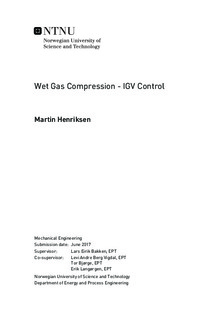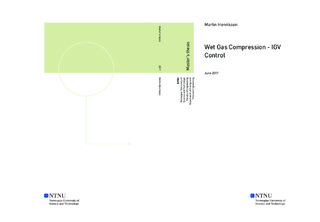| dc.description.abstract | Wet gas compression and subsea technology has gained increased attention in the recent years. Subsea compression increase extraction from aging gas fields and make remote fields profitable. Wet gas compressors eliminate the need for subsea separation, which reduces capital- and operational cost. In turbomachinery, the common practice is to utilize variable inlet guide vanes (VIGV) to manage variations in inlet condition parameters. Stable compressor performance and operation at maximum efficiency point is desirable from both a mechanical and economical point of view. The effect of VIGV on wet gas compression is therefore of specific interest.
A variable inlet guide vanes system has been examined in combination with a single stage centrifugal compressor. The main objective was to assess the influence wet gas has on the VIGV performance, how VIGV performs compared to variable speed drive (VSD) and how the VIGV could be utilized to keep stable compressor performance with varying liquid content. Four different test have been conducted at the NTNU test facility.
VIGV performance has been studied at the following gas mass fractions (GMF); 1.0, 0.98, 0.95, 0.90, 0.80, 0.70 and 0.60. For each of the different values of GMF, the compressor performance was recorded, while the VIGV angle was changed from maximum prewhirl to maximum counter whirl. These experiments resulted in the following findings:
- The VIGV effect on pressure ratio and volume flow declines with increasing liquid content. This is due to the increased momentum transfer between liquid and gaseous phases.
- Increasing liquid content correlated with increased pressure ratio and reduced volume flow. With one exception at GMF 0.98, the pressure ratio and the volume flow increased compared to the dry gas cases.
- The performance of VIGV compared to the performance of VSD differed little with respect to both volume flow and pressure ratio.
- When the VIGV provided counter whirl the overall efficiency of the compressor decreased compared to the VSD controlled compressor case.
To show that the VIGV could be used to keep stable compressor performance with varying liquid content, the inlet composition was changed from dry gas to the following GMF; 0.9, 0.8 and 0.7. The VIGV and the outlet valve were used to keep the same pressure ratio and volume flow independent of liquid content. For GMF 0.9 and GMF 0.8 the VIGV was used to lower the compressor performance by inducing prewhirl. While for GMF 0.7 the compressor performance was increased by inducing less prewhirl. The maximum change in VIGV angle needed was 3.5°.
Utilization of VIGV was demonstrated as an efficient method to adjust the compressor performance with varying inlet liquid conditions, even though the VIGV effect on pressure ratio and volume flow decreased with increasing liquid content. | |

